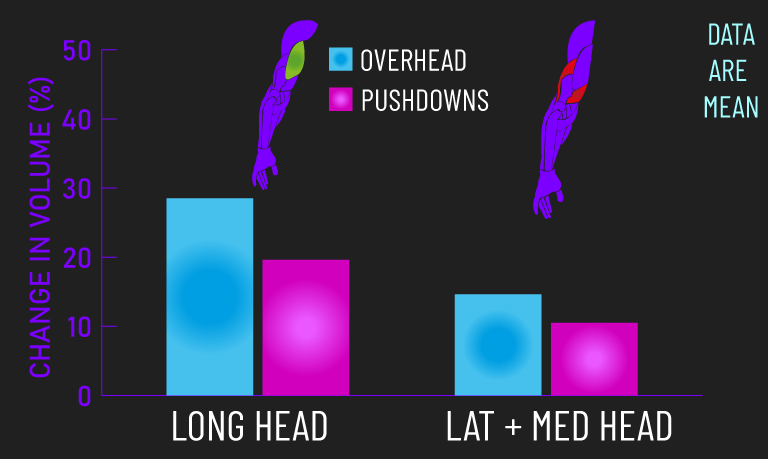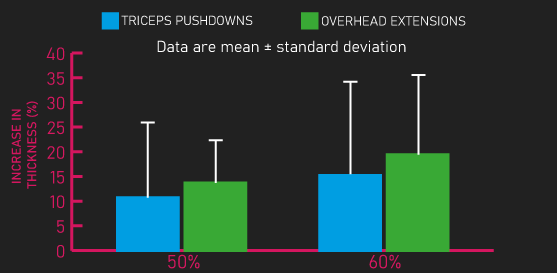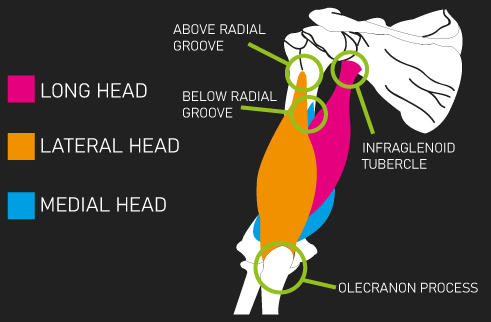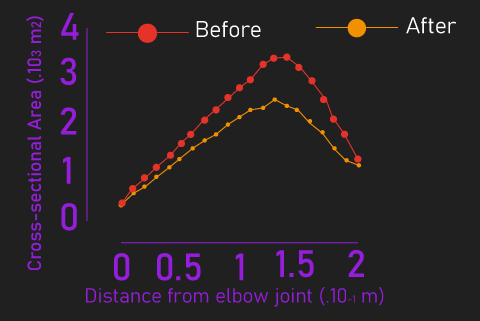
A brand new study out of Japan by Maeo et al. has recently come out, comparing overhead extensions to pushdowns, and its findings have important implications for maxing triceps hypertrophy.
Let’s dive into this great new paper.
Part I: Overhead Extensions vs Pushdowns
21 untrained adults (comprising 14 men and 7 women) had one arm assigned to a overhead condition and their other arm assigned to a pushdown condition.
Both arms were trained across 2 sessions per week for 12 straight weeks.
The overhead condition arm trained overhead cable extensions, while the pushdown condition arm trained cable pushdowns.

Both exercises were performed from 0 to 90 degrees of elbow flexion, and with a supinated grip (I’m not too sure why the researchers opted to employ a supinated grip).
Every session, the subjects alternated which condition was trained first, and both of the exercises were trained for 5 sets of 10 repetitions with 2 minutes of rest between sets.
Training loads were gradually increased at the first, second, and third sessions from 50 to 60 to 70% one-rep max, with a 70% one-rep max load used thereafter.
When a subject could not complete 10 reps on a set, a researcher spotted and assisted them to ensure the attainment of 10 reps per set.
Once a subject could complete 5 sets of 10 reps on one of their execises completey unassisted, training loads were increased by 5% next session.
Before and after the study, the reseachers measured the volume of the whole triceps, as well as the volume of the long triceps head.
As the reseachers had trouble differentiating between the lower part of the lateral and medial head, the opted to measure combined lateral and medial head volume.

It was found that whole triceps volume increases were 1.4 fold greater for the overhead versus pushdown condition.

Long head triceps volume increases were 1.5 fold greater for the overhead versus pushdown condition, and combined medial and lateral head volume increases were 1.4 fold greater for the overhead versus pushdown condition.

Thus, overhead extension grew the triceps notably more than pushdowns.
This study isn’t the only one comparing overhead extensions to pushdowns, one other paper out of Greece similarly found overhead extensions tended to grow the long head thickness at 50 and 60% of the upper arm region more than pushdowns. No other triceps regions were assessed unfortunately.

Now, this finding ended up not being classed as statistically significant, and is likely related to the sample size of 9 individuals plus the study only lasted 6 weeks. Yet, it’s important to understand statistical insignificance doesn’t necessarily mean no difference.
Part II: The Stretch Is Powerful
As we know, the triceps consists of the long, medial, and lateral head.

The medial and lateral head only pass over the elbow joint, and thus are called single-joint muscles.
The long head passes over both the elbow and shoulder joint, and thus is called a two-joint muscle.
Due to this structural point, the long head is stretched when placed overhead.
And this likely explains one of the findings of the Maeo study, that long head hypertrophy is significantly enhanced with overhead extensions versus pushdowns.
There’s a growing body of research demonstrating achieving a stretch during an exercise is powerful for evoking muscle hypertrophy.
A previous study by the same researchers, Maeo et al., evaluated the hamstrings, expect for the biceps femoris short head, which is a one-joint muscle that only crosses the knee, all the other heads of the hamstrings are two-jointed as the cross the knee and hip joints.

Due to this structural point, seated curls are going to stretch all the two joint hamstring muscles more than lying leg curls.

And guess what? The researchers found hypertrophy of all the two-joint hamstring muscles were much greater with seated versus lying leg curl training, while biceps femoris short head hypertrophy was similar between both exercises.

Research examining isometric training finds that training at stretched muscle lengths produces notably more hypertrophy than training at shortened muscle lengths.
The range of motion literature tells us the same story. Partial range of motions that train the muscle in shortened positions produce less hypertrophy versus fuller ranges of motions that achieve stretch of a muscle.
Matter of fact, a 2021 study out of Brazil by Pedrosa et al. actually found that partial range of motion leg extensions training the quads in a stretched position produced overall more hypertrophy versus a full range of motion. Though, more research is needed to examine comparisons between stretched partial range of motion training and full range of motion training.
Nevertheless, it’s crystal clear the science demonstrates that stretch is powerful for muscle hypertrophy.
Returning back to the Maeo triceps findings, it unexpectedly also found overhead extensions evoked greater collective medial and lateral head growth versus pushdowns.
We know the medial and lateral heads are single-joint, and so are not stretched any more during overhead extensions than pushdowns, so what explains this finding?
Two speculations were provided in the paper.
Firstly, the researchers simulated models and found that during overhead extensions, the long head operated on the descending limb of the force-length curve. For those who have no clue what this means, it’s simply saying the long head may not be able to produce much active contractile force during overhead extensions, perhaps resulting in the nervous system evoking stronger force contributions for the lateral and medial head.
Thus maybe this explains why the lateral and medial head also grew more with overhead extensions.
The second speculation was that overhead extensions, due to the overhead arm positioning, would restrict blood flow to the muscle more than pushdowns. This would likely result in overhead extensions producing greater metabolic stress (the build of metabolites), something that’s proposed to potentially drive hypertrophy. However, a limitation with this speculation is there are many cases where more metabolic stress isn’t associated with more hypertrophy, thus the role of metabolic stress in hypertrophy is questionably and not super clear currently.
Before moving on, if you’re curious about creating an effective training program for muscle hypertrophy, our high quality partner Alpha Progression can help. It can generate a highly effective program for you, track your workouts live with in-built progression recommendations, provide graphs displaying your long term progress, and it has a massive exercise database with more than 550 exercises.
Click HERE (the link opens in a new tab) to get a free 2 week trial of the apps features. If you like it and go beyond, the link also gives you 20% off a subscription!
We never promote trash at the House of Hypertrophy, so rest assured the app is high quality. The reviews speak to this, 4.8 starts (based on more than 7,000 reviews) on Google play, and 4.9 stars in Apple’s store (based on nearly 400 ratings).
Part III: Overhead Extensions Enough for Triceps?
Based on the data we’ve overviewed, it’s likely some kind of overhead extension in your training is needed to max triceps hypertrophy.
For those who care more about efficiency, you do not wish to do much exercise variation and/or training volume, and you’re not overly concerned about meticulously maxing triceps gains, overhead extensions alone can probably do this job.
Yet, for those wanting to do the utmost to develop the triceps, I’m skeptical overhead extensions alone would be sufficient.
You see, the Maeo study examined volume of the overall triceps, the long head, and the combined lateral and medial heads. Volume is a great muscle growth measurement, as it’s 3 dimensional and incorporates all regions. However, volume does not consider regional hypertrophy differences.
Regional hypertrophy is the phenomenon where muscles do not grow evenly across its regions, and numerous studies validate its existence.
Different triceps exercises could preferentially develop different regions of the triceps, meaning a combination of a few triceps exercises are needed to max overall regional gains.
In fact, we have research alluding to this.
A study out of Japan by Kawakami et al. found after training dumbell overhead extensions for 16 weeks, the overall triceps mainly developed in the slightly upper regions.

A different study out of Japan by Wakahara et al. found after training dumbbell skullcrushers for 12 weeks, the overall triceps mainly developed in the middle regions.

Thus, the combination of overhead extensions with skullcrushers is a good idea to regionally develop the triceps.
Furthermore, it’s possible pushdowns themselves target slightly different triceps regions compared to overhead extensions and skullcrushers, so the inclusion of pushdowns too might be beneficial. But more research is needed to validate this.
Part IV: Summary
Stretch is powerful for muscle hypertrophy, and the greater stretch of the long head with overhead extensions versus pushdowns is a strong candidate to explain the greater long head hypertrophy attained with overhead extensions.
Fascinatingly, the medial and lateral heads also collectively grew more with overhead extensions, for mechanisms that are currently unknown.
Ultimately, overhead extensions are likely a must for maxing triceps development.
For those who purely care about efficiency, simply training only overhead extensions will certainly deliver great gains.
For those more meticulous, you probably want to add at least some kind of skull crusher with overhead extensions, as evidence indicates these exercises may target slightly different regions. It’s possible pushdowns also target different regions, but we don’t have concrete data demonstrating this, so it’s your call if you want to add pushdowns in too.
Remember to feel free to check out the Alpha Progression App if you’re interested. Also feel free to check out our free bench press e-book below.

